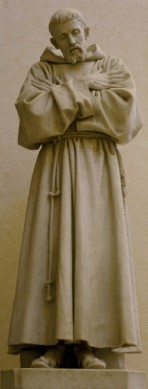
(click picture to embiggen)
Over at The New Liturgical Movement, there have been some comments saying that with the motu proprio "Summorum Pontificum" the "reform of the reform" movement has become ignored and that everyone is focusing only on the extra-ordinary form of Mass now.
This got me to thinking a bit about that statement, and where myself and my own blog fit into that. In this blog's very first post, I said that I wanted to use this blog to share whatever liturgical knowledge I had. It was only after starting and seeing some of the excellent liturgical blogs out there (like The New Liturgical Movement and Fr. Z's What Does the Prayer Really Say) that I realized I had a lot to learn. However, having visted many monasteries and religious houses, having worked as a sacristan at a basilica in Italy and a few parishes here in the States, some of that experience, and the great wealth of information I have learned from studying liturgy over the years have begun to come together. A lot of what has been needed is a liturgical perspective that I first and foremost credit to Cardinal Ratzinger/Pope Benedict XVI. With his writings and especially with "Summorum Pontificum" it is as though he has opened a floodgate of liturgical discussion which I believe is beginning to produce great fruit. While I don't necessarily expect a major liturgical reform in my lifetime, I do think he has begun to lay the foundation for a true renewal of liturgical understanding, mostly from his hermenutic of continuity: of looking at the whole of the Church's Tradition.
One of the bad fruits of the "spirit of Vatican II," was that there was a mental rupture from the Church's Tradition in many of the faithful. I say mental rupture because there was not a doctrinal rupture on the Church's part, just an attitude amongst the faithful (even some leaders in the Church) where suddenly Vatican II was seen as a point at which anything before Vatican II is now obsolete, and only Vatican II and anything after that pertains to the Church in the modern world. What Pope Benedict has helped me to do is to break me of that mindset and to look at the whole of the Church's Tradition, and I don't just mean the Roman Church, I mean the entire Church, the Roman Rite, the Western Rites, the Eastern Rites and other Catholics around the world and throughout history.
So, where does this blog fit into all that? I don't think I'll ever be able to nail that down. But getting back to the initial question of the "reform of the reform" vis-a-vis the extra-ordinary form of the Mass that has been placed back on an equal standing with the ordinary form by "Summorum Pontificum," I can say that the motu proprio has actually put more "pressure" on the ordinary form to get it's act together. I don't mean that the Novus Ordo is to be changed to be more like the extra-ordinary form. That's something for the Church to do with an organized reform of the liturgy. "Vigilante liturgical reform" is not the answer to the problems in the Novus Ordo Mass. What I mean is to get the Novus Ordo back on track and to start getting it said as it is supposed to be said. We'll worry about actually reforming the ordinary use later. First we need to just get it said by the books.
I work in a normal diocesan parish, so the extra-ordinary form is something that may be able to be done on occasion, but since it is a parish, the ordinary form is what will be done the majority of the time. That's completely to be expected. "Summorum Pontificum" is not calling for the "Novus Ordo" to become the "Tridentine" or for the "Tridentine" to take over the "Novus Ordo. That's not what the Pope said at all. He merely made the "Tridentine" an easily accessable option for those who prefer it. In a typical parish, the ordinary form is still what will be celebrated as the norm. But hopefully the understanding that the "Tridentine" has to be said with such accuracy will influence those involved with the "Novus Ordo" to carry it out with the same accuracy according to its own instructions, rubrics, and ritual.
Thus, I would say that that is one of the goals of this blog: To help foster an understanding of the instructions, rubrics, and ritual of the Novus Ordo Mass ... even if I personally prefer the extra-ordinary ("Tridentine") form of the Mass. I do this because the extra-ordinary form of the Mass is not what has the problems. Those who want it respect it and say it as it is supposed to be said. The problem is in the chaos of the liturgical reforms of Vatican II, all sorts of things were introduced, especially a mindset that you can add anything to the Mass. I think this mindset is the first and greatest difficulty to get over. I have seen this in many, many priests formed after Vatican II, and I would say that even I have fallen into it myself in the past. Although I was always against goofy "liberal" changes, I had no problems with pius or reverent changes. But changes are changes. The Chruch gives instructions for each use and rite, and those are to be followed, not just because it is the law, but because it shows a unity with and obedience to the Church and a unity with that particular Tradition.
One of my first goals is that I would like to go through the 2002 General Instruction on the Roman Missal. The first time I read it, I was absolutely amazed that the Church actually gave such specific instructions on how the Novus Ordo Mass is supposed to be done. That document was what sort of woke me up to the fact that you can't just do whatever you want, you have to actually follow the books (suddenly Canon #846 Pt 1 made sense). Then I got ahold of the "Ceremonial of Bishops" and was amazed to see even more detailed instructions on the Mass. I suddenly saw that there is no real need for "creativity" (which is the same "creativity" that the Pope condemns in his accompanying letter to "Summorum Pontificum") because the actions of the modern liturgy are already laid out for the priest. Sure there might be a few more "options" in the Novus Ordo, but even those are specifically mentioned as options only for this or that particular part or situation in the Mass.
So, on your litany of things for which to pray for me, include that I can learn and understand better the liturgical understanding of not only the "Novus Ordo" and the "Tridentine" but also the bigger picture of the Church's liturical theology. I feel that this will be a difficult process, but one which will bear much fruit in the future.
RS






1 comment:
Hello...
"I work in a normal diocesan parish, so the extra-ordinary form is something that may be able to be done on occasion, but since it is a parish, the ordinary form is what will be done the majority of the time."
I appreciate that you wrote the above last year.
Cardinal Castrillion has since stated that the Holy Father desires that the TLM become a normal part of each (Latin Rite) parish.
Would you then consider that the following statement..."so the extra-ordinary form is something that may be able to be done on occasion..." is to be revised?
In other words, regarding the TLM, we have moved beyond "occasional" celebrations to frequent celebrations.
Thank you.
Post a Comment